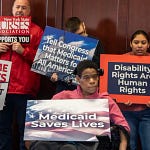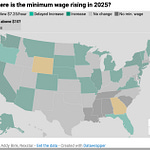I wrote this essay a few years ago, and as you can see, it eventually became the basis for this newsletter. I’m publishing it today, with just a few tweaks, because I’ve been off tending to my ailing dog (you’ll recognize his photo below as my crack research assistant for this newsletter), but also to remind my readers and me why I’m writing Crime and Punishment.
This essay touches on many of the ideas I have already discussed in individual posts and includes a few scenarios from my personal experiences to illustrate how regular, educated people (like me) can get caught in the cycle of debt and poverty.
The Catch-22 of Poverty
There’s something strange about poverty in America today. It is more pervasive than most realize, yet somehow remains elusive — unable to be pinned down, grabbed hold of and tossed away for good. I’m tempted to say “this isn’t your grandparents’ poverty”, although my paternal grandparents and their six children managed to land on the other side of the Great Depression. My Italian immigrant grandfather was an entrepreneur of sorts, and owned a store, a hotel and a large home until the scourge of the depression hit. Their family never fully recovered financially, but help came in the form of federal government programs that provided jobs, our country’s baseline social safety net, and an investment in our collective future with the G.I Bill, without which my father likely would not have been the first in his family to graduate college.
But today’s poverty is different. It doesn’t have a name: there is no depression and we’re over a decade out from the Great Recession. In fact, what our government uses as economic indicators say we’re doing well despite moving into year three of a pandemic that flattened our economy — unemployment is way down and our economy continues to grow. Yet, as of the 2020 Census, over 37 million Americans live at or below the federal poverty level, and millions more suffer with financial insecurity. We are clearly doing something wrong.
Since the Great Depression, we’ve vowed to ‘break the cycle of poverty”, declared a “war on poverty” in the 1960’s and are now gamely resurrecting that fight through religious coalitions, like the one led by the Reverend William Barber. While these movements might make some inroads, they likely won’t create the paradigm shift in our thinking about the primacy of business over people, or lead to changes in our current laws which not just allow, but encourage and incentivize private businesses to wring every last penny from our poorest citizens.
If it sounds like I’m saying the system is rigged, I am and it is.. But I’m not saying it’s a silent conspiracy – it's right out there for all to see in the industries that create our “credit scores” and allow many lending institutions and pay day loan vipers to charge nearly 600% interest, for example. How can the unemployed, underemployed and working poor (nearly one of nine of those who work full time meet the federal poverty guidelines for their family size), ever pull themselves out of poverty when the odds are stacked against them by the very system they’re trying to make good in? It’s as mind-boggling and cruel a Catch-22 as ever dreamed up.
The concept of credit scores was created in the 1950’s, and after much revamping, was officially launched in 1989 in an attempt to make lending more fair. Before Fair Issac Company (now FICO) came along with their algorithms for determining whether a person is a good credit risk, individuals usually obtained credit from meeting with their local banker. This could, and often did, result in discriminatory lending practices that left millions of minorities and women without access to credit. FICO’s purportedly unbiased software system, which doesn’t rely on face-to-face judgements, likely has reduced lending discrimination overall. But FICO and the three major credit reporting agencies, TransUnion, Experian and Equifax are for-profit companies, and although regulated by the Fair Credit Reporting Act, the algorithms FICO develops and sells to the credit reporting agencies to determine credit scores, remain proprietary. Yet, these three-digit numbers can determine the quality of your life: whether you have access to even basic shelter and transportation, a job, a loan or a competitive insurance premium.
Once a person is in debt, the suggestions to improve that situation range from insulting (borrow from family or friends!) to downright crazy. One way to pay down debt, credit experts intone, is to simply allocate more each month to paying off high interest credit cards. For example, when I had about $10,000 in credit card debt, the “Action Plan” provided with my free credit score urged me to pay all of my bills on time and put an extra $400 toward my three credit cards and personal loan each month. What? During 2017, I grossed just under $17,000 from my three part-time jobs in education (college adjunct and tutor), and by the start of 2018, I hadn’t paid my mortgage in eight months. Of course I would pay my bills on time if I had the money to do so, and where would I or even most middle-class people get an extra $400 a month, when according to recent statistics, four in ten Americans would not be able to raise $400 for an emergency?
After eight late mortgage payment hits to my credit, maxing out my credit cards and applying for (and being denied) loans to consolidate my debt, my FICO score was in the high 500’s. Short of a Powerball win, it was impossible to raise my credit score because I was in debt without enough income to pay it off, and I got in debt because I still had to function — you keep charging to keep functioning, and you must keep functioning to keep your jobs.
Of course, the more debt you have, the lower your credit score, and the lower your credit score, the higher the interest rate you’re charged, and the higher your interest rate, the more debt you accumulate because you’re paying much more toward interest than principal. This is the real cycle of poverty that makes it nearly impossible to pay down, let alone pay off, debt, and the only way to break this cycle is to do what has proven elusive: get money.
This cycle and everything that establishes it and keeps it going are sanctioned by our laws and policies, or lack thereof. Few people seem to challenge the way things are, probably because they’re too busy working more than one low wage job and taking care of their families to have energy reserves left to challenge anything.
And we know how financial desperation can lead to poor choices and outcomes. A few years ago, I received a “loan by mail product” or “live check” in the mail for $2,539 from a finance company which offers loans to those with poor credit and currently has offices in 22 states. After several phone calls with my local branch to confirm interest rates and pre-payment penalties, I cashed the check. There was a $110 service fee added on to the loan balance, so I paid 26.6% APR on $2,649. After eight timely payments of $95 each, the remaining principal balance on the loan was $2,465.90: I paid a total of $760, with only $183.10 applied to principal and $576.90 in interest.
Still in need of cash to bridge the gap between adjunct paychecks, I borrowed another $500 from the same company. This entailed refinancing the original loan for which I paid a prepaid finance charge of $222 at an APR of 30%. Yes, I paid over $200 to get $500, and this wasn’t even a payday loan. Only by a literal act of God (an insurance check received from a storm-flooded basement) was I able to pay off this debt.
What can help break this cycle of debt and poverty are laws that allow consumers to more easily understand and challenge the credit scores assigned to them, and limit both usury interest rates and skewed loan structures by federal regulation. And a guaranteed basic income, at least for those who earn below a certain annual income, is probably the only way to eliminate poverty.
Maybe the reason why poverty and economic insecurity seem unsolvable is because the cycle of poverty is embedded in our laws, policies and business-first culture, and money and access to it are one big Catch-22.
__________________________________________________________________________
Let me know what you think of these issues in the comment section below. Have you been in debt and couldn’t scrape your way out? Did you get help from friends or family? Are you still struggling to pay your bills? Have at it!
If you like what you just read, feel free too share it with friends and family.
And if you don’t already have a free or paid subscription to Crime and Punishment, you can sign up right quick by adding your email address below—thanks!
















Share this post